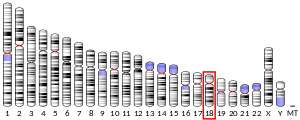Centrosomal protein of 76 kDa, also known as CEP76, is a protein that in humans is encoded by the CEP76 gene.[5][6]
Further reading
- Rual JF, Venkatesan K, Hao T, et al. (2005). "Towards a proteome-scale map of the human protein-protein interaction network". Nature. 437 (7062): 1173–8. doi:10.1038/nature04209. PMID 16189514.
- Golsteyn RM, Mundt KE, Fry AM, Nigg EA (1995). "Cell cycle regulation of the activity and subcellular localization of Plk1, a human protein kinase implicated in mitotic spindle function". J. Cell Biol. 129 (6): 1617–28. doi:10.1083/jcb.129.6.1617. PMC 2291169. PMID 7790358.
- Casenghi M, Meraldi P, Weinhart U, et al. (2003). "Polo-like kinase 1 regulates Nlp, a centrosome protein involved in microtubule nucleation". Dev. Cell. 5 (1): 113–25. doi:10.1016/S1534-5807(03)00193-X. PMID 12852856.
- Gerhard DS, Wagner L, Feingold EA, et al. (2004). "The Status, Quality, and Expansion of the NIH Full-Length cDNA Project: The Mammalian Gene Collection (MGC)". Genome Res. 14 (10B): 2121–7. doi:10.1101/gr.2596504. PMC 528928. PMID 15489334.
- Ota T, Suzuki Y, Nishikawa T, et al. (2004). "Complete sequencing and characterization of 21,243 full-length human cDNAs". Nat. Genet. 36 (1): 40–5. doi:10.1038/ng1285. PMID 14702039.
- Mayor T, Stierhof YD, Tanaka K, et al. (2000). "The Centrosomal Protein C-Nap1 Is Required for Cell Cycle–Regulated Centrosome Cohesion". J. Cell Biol. 151 (4): 837–46. doi:10.1083/jcb.151.4.837. PMC 2169446. PMID 11076968.
- Strausberg RL, Feingold EA, Grouse LH, et al. (2002). "Generation and initial analysis of more than 15,000 full-length human and mouse cDNA sequences". Proc. Natl. Acad. Sci. U.S.A. 99 (26): 16899–903. doi:10.1073/pnas.242603899. PMC 139241. PMID 12477932.
- Petretti C, Savoian M, Montembault E, et al. (2006). "The PITSLRE/CDK11p58 protein kinase promotes centrosome maturation and bipolar spindle formation". EMBO Rep. 7 (4): 418–24. doi:10.1038/sj.embor.7400639. PMC 1456919. PMID 16462731.
- Takahashi M, Yamagiwa A, Nishimura T, et al. (2002). "Centrosomal Proteins CG-NAP and Kendrin Provide Microtubule Nucleation Sites by Anchoring γ-Tubulin Ring Complex". Mol. Biol. Cell. 13 (9): 3235–45. doi:10.1091/mbc.E02-02-0112. PMC 124155. PMID 12221128.
- Tsang WY, Spektor A, Vijayakumar S, et al. (2009). "Cep76, a centrosomal protein that specifically restrains centriole reduplication". Dev. Cell. 16 (5): 649–60. doi:10.1016/j.devcel.2009.03.004. PMID 19460342.
- Lim J, Hao T, Shaw C, et al. (2006). "A protein-protein interaction network for human inherited ataxias and disorders of Purkinje cell degeneration". Cell. 125 (4): 801–14. doi:10.1016/j.cell.2006.03.032. PMID 16713569.



